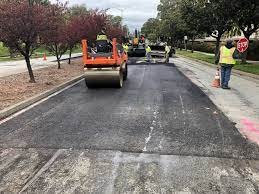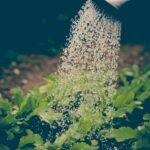Urban roads face challenges like traffic, stops, and space constraints, needing specialized surfacing. This guide explores durable, cost-effective options like asphalt overlays and advanced materials, with insights on their benefits and uses.
Traditional Asphalt Surfacing Methods
Hot Mix Asphalt Overlays
Hot mix asphalt (HMA) remains the most common urban surfacing technique due to its versatility and proven performance. This method involves heating asphalt cement and aggregates to approximately 300°F, creating a workable mixture that can be laid and compacted while hot.
Urban applications particularly benefit from HMA’s ability to conform to existing road contours and provide immediate traffic-bearing capacity once cooled. The technique works well for arterial roads, residential streets, and commercial areas where smooth, quiet surfaces are priorities.
However, HMA requires significant equipment and generates considerable emissions during production and application. Cities increasingly seek alternatives for environmentally sensitive areas or projects with sustainability goals.
Cold Mix Applications
Cold mix asphalt offers advantages in urban settings where hot mix application proves challenging. This technique uses cutback asphalts or emulsions that don’t require heating, making it suitable for small repairs, temporary surfaces, and areas with limited equipment access.
Urban utility cuts frequently use cold mix for quick restoration, though the long-term durability doesn’t match hot mix performance. Asphalt paving like that in Salt Lake City demonstrates the importance of quality materials for lasting results. The technique serves as an effective interim solution while planning comprehensive reconstruction projects.
Advanced Urban Surfacing Techniques
Microsurfacing and Slurry Seals
Microsurfacing represents a significant advancement in preventive maintenance for urban roadways. This technique applies a thin layer of polymer-modified emulsion, fine aggregates, and additives to restore surface texture and seal minor cracks.
The process requires minimal traffic disruption, with roads typically reopening within one to four hours. Urban areas benefit from microsurfacing’s ability to improve skid resistance, reduce water infiltration, and extend pavement life by five to seven years.
Slurry seals provide similar benefits for residential streets and parking areas, though they offer less durability than microsurfacing. Both techniques prove cost-effective for maintaining urban road networks before major rehabilitation becomes necessary.
Stone Matrix Asphalt
Stone matrix asphalt (SMA) addresses specific urban challenges through its unique aggregate structure. This technique creates a stone-to-stone contact framework bound by a rich mastic of bitumen and filler, resulting in exceptional durability and rut resistance.
Urban arterials and bus routes particularly benefit from SMA’s ability to withstand heavy loading and channelized traffic. The technique provides excellent surface texture for wet weather traction while minimizing maintenance requirements over its service life.
Implementation costs exceed conventional HMA, but the extended performance and reduced maintenance needs often justify the investment for high-traffic urban corridors.
Innovative Materials and Methods
Recycled Asphalt Pavement Integration
Urban roadway projects increasingly incorporate recycled asphalt pavement (RAP) to reduce material costs and environmental impact. Modern techniques can successfully integrate 15-30% RAP content while maintaining performance standards.
Cities benefit from reduced disposal costs for existing pavement materials while decreasing demand for virgin aggregates. Advanced mixing techniques and rejuvenating agents ensure proper bonding between recycled and new materials.
Some urban projects achieve even higher RAP percentages through warm mix technologies that improve workability at lower temperatures. This approach aligns with municipal sustainability goals while maintaining fiscal responsibility.
Warm Mix Asphalt Technologies
Warm mix asphalt (WMA) reduces mixing and compaction temperatures by 50-100°F compared to traditional hot mix, offering significant advantages for urban applications. Lower temperatures mean reduced emissions, improved working conditions, and extended hauling distances without temperature loss.
Urban projects benefit from WMA’s reduced odors and steam generation, making it more acceptable in densely populated areas. The technique also allows for longer paving seasons in colder climates and can incorporate higher percentages of recycled materials.
Several WMA technologies exist, including chemical additives, organic additives, and foaming techniques. Each offers specific benefits depending on local materials, climate conditions, and project requirements.
Specialized Urban Applications
Porous Asphalt for Stormwater Management
Urban areas increasingly adopt porous asphalt surfacing to address stormwater management challenges. This technique creates a permeable surface that allows water to infiltrate through the pavement structure into underlying stone reservoirs.
The approach reduces surface runoff, minimizes flood risks, and can help cities meet stormwater management regulations. Porous asphalt works particularly well for parking areas, residential streets, and pedestrian paths where traffic loads remain moderate.
Proper subgrade preparation and regular maintenance are critical for long-term success. Urban applications require careful consideration of soil conditions, groundwater levels, and potential contamination sources.
Colored and Decorative Surfacing
Urban environments often demand surfacing solutions that serve both functional and aesthetic purposes. Colored asphalt techniques use pigments or colored aggregates to create visually appealing surfaces for pedestrian areas, bike lanes, and architectural zones.
These specialized surfacing methods help define traffic patterns, enhance safety through visual contrast, and contribute to urban design goals. Bus lanes, crosswalks, and intersection treatments frequently employ colored surfacing to improve visibility and traffic management.
Implementation requires careful attention to color durability, slip resistance, and maintenance requirements. Urban applications must balance aesthetic goals with long-term performance expectations.
Conclusion
Choosing the right urban roadway surfacing technique involves assessing traffic, pavement condition, environment, and budget. Consulting pavement engineers and starting with pilot projects can help determine the best approach. Regular maintenance is essential to address minor issues early and extend roadway service life.









